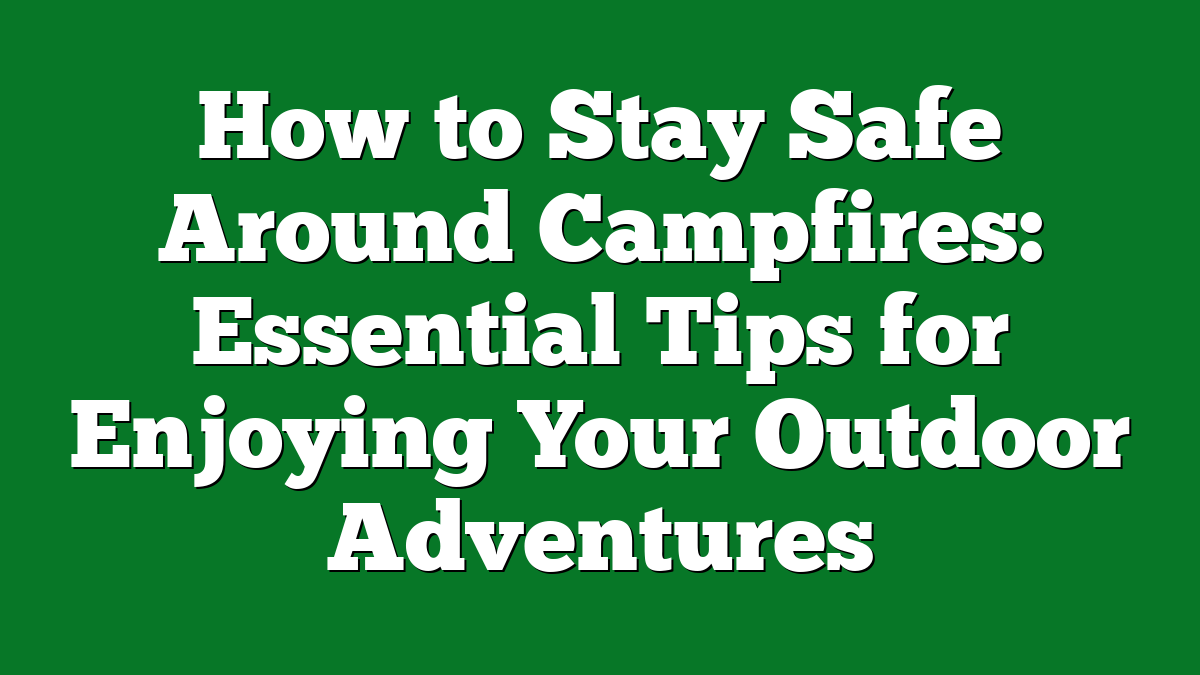There’s nothing quite like gathering around a campfire, sharing stories and roasting marshmallows under the stars. It’s a magical experience that brings friends and family together. But while the warmth and glow of the fire create a cozy atmosphere, it’s essential to remember that campfires can be dangerous if not handled properly.
Understanding Campfire Safety
Campfires create warmth, light, and a gathering spot under the stars. Emphasizing safety ensures every outdoor experience remains enjoyable and free from accidents.
Importance of Campfire Safety
Prioritizing campfire safety prevents injuries and uncontrolled wildfires. I always make sure to establish a safe distance between the fire and my tent, gear, or any overhanging branches. Creating a designated fire ring with stones aids in preventing the spread of flames. Knowing local regulations and fire bans is a must, as these help protect both the environment and fellow campers.
Risks Associated with Campfires
Campfires present several risks that campers should recognize:
- Burn Injuries: Flames and hot embers can cause serious burns. I keep a close watch on children and pets around the fire, ensuring they’re at a safe distance.
- Wildfires: Unattended fires or improper extinguishing can lead to wildfires. I always keep a bucket of water or a shovel of dirt nearby to quickly put out the flames.
- Smoke Inhalation: Prolonged exposure to smoke can cause respiratory issues. Positioning myself upwind reduces smoke exposure, making the experience more pleasant.
- Insect Attraction: Campfires can attract insects like mosquitoes. I often use citronella candles or specific repellent plants around the area to minimize bites.
Understanding these risks enhances my camping experiences and keeps my fellow campers and I safe while enjoying the great outdoors.
Preparing for a Campfire
Preparing for a campfire involves crucial steps that ensure safety and enjoyment. I always take care to choose a proper location and gather safe materials.
Choosing the Right Location
Choosing the right spot for a campfire makes all the difference. I look for areas at least 15 feet away from tents, gear, and overhanging branches. A flat, open space reduces hazards and keeps the fire contained. I also check local regulations to confirm any restrictions, ensuring I respect fire bans if they exist. Refraining from setting up a fire in windy conditions prevents embers from blowing around.
Gathering Safe Materials
Gathering safe materials is essential for a controlled and enjoyable fire. I gather dry wood in three sizes: tinder, kindling, and fuel wood. Tinder consists of small twigs or dry leaves, perfect for igniting the flame. Kindling, such as sticks or small branches, helps the fire grow. Finally, I gather larger logs to sustain the fire. I avoid using flammable liquids or gasoline, as these can lead to dangerous flare-ups. Using seasoned wood reduces smoke and improves overall fire quality.
By taking these steps, I ensure a safe and enjoyable campfire experience for myself and my fellow campers.
Building a Safe Campfire
Creating a safe campfire enhances the camping experience while ensuring everyone stays protected. I prioritize safety when preparing my fire, understanding that a well-built campfire not only provides warmth but also lights up stories shared late into the night.
Selecting the Right Fire Pit
Choosing the right fire pit is crucial for safety and functionality. I look for a flat, clear area at least 15 feet from tents and flammable materials. I often use designated fire rings or stone circles to contain the fire, reducing the risk of spread. It’s essential to confirm that the fire pit complies with local regulations, especially in areas with fire restrictions. If rules permit, I dig a small pit, ensuring the surrounding area is clear of debris.
Building Techniques for Safety
Using proper building techniques makes a significant difference. I start with tinder, placing dry leaves or small twigs in the center of my fire pit. Surrounding the tinder with kindling—thin sticks or small branches—helps the fire grow. I avoid using flammable liquids, which can create dangerous flare-ups. Once the kindling catches fire, I gradually add larger pieces of fuel wood. To maintain safety, I never leave the fire unattended and always keep a bucket of water or sand nearby for extinguishing purposes.
Following these guidelines not only ensures a safe campfire but also makes for memorable nights under the stars.
Maintaining Campfire Safety
I’ve spent countless nights around a campfire, enjoying the warmth and camaraderie. To fully enjoy this experience, maintaining campfire safety is key. Following a few specific guidelines ensures that every camping trip remains memorable and safe.
Monitoring the Campfire
I constantly keep an eye on the campfire. Always watch for shifting winds or a sudden gust that could spread embers. It’s essential to check in on the fire, especially when it pops and crackles. Everyone in the group should share this responsibility, ensuring we’re all attentive. I also keep kids and pets at a safe distance, establishing a clear perimeter around the fire to prevent accidents. When we finish cooking or roasting marshmallows, I make sure the flames diminish before leaving the area, ensuring active supervision at all times.
Proper Fire Extinguishing Techniques
Properly extinguishing the fire matters as much as building it. I often keep a bucket of water or sand nearby for quick access. When it’s time to put the fire out, I pour water over the flames while stirring the embers with a stick to expose any hidden hot spots. Before leaving, I check that everything’s cold to the touch. Another method involves covering the fire pit with dirt, ensuring no embers remain. I make it a point to leave the campsite as I found it, minimizing any environmental impact while keeping myself and others safe.
Post-Campfire Safety
Post-campfire safety is crucial to preserving nature and ensuring a safe experience for everyone. After the warmth and joy of a campfire, proper cleanup and monitoring can prevent accidents and protect the environment.
Cleaning Up After the Fire
Cleaning up after I’ve extinguished the fire is essential. I always ensure I dispose of leftover wood, ash, and any debris properly. I place cold ashes in a metal container to avoid any chance of rekindling. If I used a designated fire ring or fire pit, I make sure it’s free of any leftovers and debris. I avoid using biodegradable materials as flame sources; I don’t want to attract animals that might come through later, looking for food. Packing out what I brought in keeps the area pristine for fellow campers.
Checking for Remaining Embers
Checking for remaining embers is a safety step I never skip. I pour water over the fire’s remnants while stirring the ashes to get a good mix; this cools them down thoroughly. After dousing, I feel around the area with my hand to confirm it’s cold to the touch. I look for lingering sparks or smoke, indicating that a hidden ember might still be glowing. If any embers remain, I apply more water and stir again until everything’s safely extinguished. Leaving a cold site not only safeguards future visitors but also respects the outdoors I love.
Conclusion
Staying safe around campfires is all about being mindful and prepared. I love the warmth and connection a campfire brings but I’ve learned that safety should always come first. By following the tips I shared I can enjoy those cozy nights without worry.
It’s all about choosing the right spot gathering safe materials and keeping a close eye on the fire. With a little planning and responsibility I can create wonderful memories while ensuring everyone stays safe. So let’s embrace the magic of campfires but always remember to respect their power. Happy camping!











